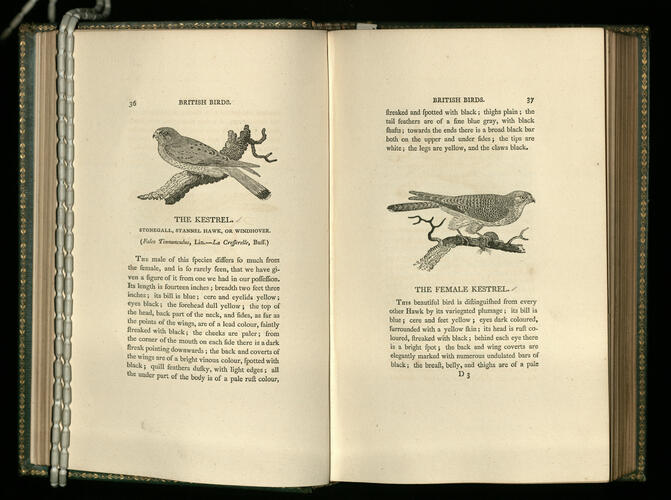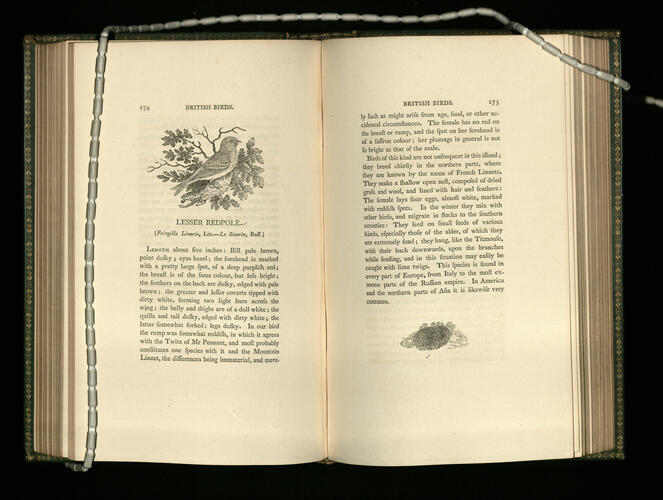-
1 of 253523 objects
History of British birds ; v. 1 containing the history and description of land birds / the figures engraven on wood by T Bewick 1797
27.0 x 17.5 x 4.3 cm (book measurement (conservation)) | RCIN 1055617

Thomas Bewick (1753-1828)
History of British birds ; v. 1 containing the history and description of land birds / the figures engraven on wood by T Bewick 1797

Thomas Bewick (1753-1828)
History of British birds ; v. 1 containing the history and description of land birds / the figures engraven on wood by T Bewick 1797

Thomas Bewick (1753-1828)
History of British birds ; v. 1 containing the history and description of land birds / the figures engraven on wood by T Bewick 1797




-
Thomas Bewick was a Newcastle-based publisher and natural history author. Born at Cherryburn in Northumberland, Bewick was apprenticed to the engraver Ralph Beilby, from whom he learned how to engrave on wood and metal. Beilby preferred the latter, leaving his apprentice to learn the former. The young Bewick showed an immediate aptitude, quickly developing his own techniques that earned him a medal from the Royal Society of Arts in 1775 for his designs. The innovations popularised by Bewick saw carvings made against the grain of the wood with tools normally reserved for metal engraving. This allowed for much greater detail and subtler shading in the resulting print compared to a traditional woodcut.
Becoming a partner in 1776, the business became recognised for the fine quality of its engravings. In 1790, Bewick and Beilby published their History of Quadrupeds (referred to by Bewick simply as 'Quads'), a natural history of four-legged animals (see RCIN 1055619).The book was an instant success and soon Bewick was inundated with letters from naturalists and interested amateurs. Among the keen patrons were solicitor and naturalist George Allan and Thomas Pennant, who saw Bewick as a prospective successor and encouraged him to write about species he had omitted from his British Zoology. In the autumn of 1790, Beilby received a letter from Sir Joseph Banks via the local naturalist Marmaduke Tunstall, urging the pair to begin a history of birds.
Bewick had mentioned a possible book on birds to Allan and the Durham historian William Hutchinson in 1786, but the idea had depended on if Quadrupeds sold well. Given Banks’s support, Bewick and Beilby soon began work on the new project. Bewick wrote that he had held a lifelong passion for birdlife and ‘busied myself very much in reading various descriptions or accounts of them’, reading a range of natural histories of birds, some borrowed from Allan’s library at Blackwell Grange near Darlington.After Marmaduke Tunstall’s sudden death in late 1790, the following summer, Bewick was invited to his home at Wycliffe to make drawings from his large collection of natural history specimens. He also took great interest in Tunstall’s annotations to the books in his library and his extensive ornithological notes, declaring that they would be of great use for the prospective work. However, such was the wealth of information that Bewick soon declared that the project ought to be restricted to British birds only, with one volume focusing on land birds and a second on water birds.
The visit to Wycliffe was productive but Bewick quickly became frustrated with Tunstall’s museum, complaining of a ‘very great difference between preserved Specimens & those from nature, no regard having been paid at that time to place former in their proper attitudes nor to place the different series of feathers, so as to fall properly upon each other. This has always given me a great deal of trouble to get at the markings of the dishevelled plumage & when done with every pains, I never felt satisfied with them.’
As a solution, Bewick instead sought to illustrate as many birds as possible from life, from his own excursions to the hills of Northumberland, coastal visits or his daily walks through Newcastle. He also spoke to correspondents of his search for unusual and non-local species and they soon responded by sending him their own drawings, descriptions and freshly shot specimens.In the meantime, Beilby once again set about preparing the text, but soon business demands led to delays, meaning that it would take years to complete. Drawing upon both scientific and anecdotal evidence, Beilby shared the manuscript with Bewick who made corrections based upon his observations and knowledge. Sometimes these corrections were extensive, particularly for the birds found in abundance in the North East of England.
By the summer of 1796, Land Birds was in a state to allow Beilby to travel to London to set up deals with booksellers and to acquire paper. It was largely printed by September 1797 but when Beilby attempted to proclaim himself as the work’s sole author on the title page and in the introduction, Bewick objected, and the dispute was sent for arbitration. The panel heard evidence from both men and the arguments became tense, with Bewick declaring that parts of Beilby’s original manuscript were ‘trash’. To try to ameliorate the issue, the panel decided to add a nuanced paragraph giving both men credit and removed Beilby’s name as author from the title page. The work was published on 14 October 1797 and proved an instant success, with George Allan declaring he was in ‘raptures’ on receiving a copy.The History of British Birds was immensely successful on its publication. The first edition sold out by the middle of 1798 and further editions followed. Bewick published his volume on water birds in 1804, followed by a supplement in 1821 in an attempt to answer many of the questions he had been asked by his correspondents.
The informative descriptions and evocative illustrations meant that British Birds was ideal for amateurs and children. It served as inspiration for a generation of authors and artists in the nineteenth century, from Charlotte Brontë, who studied the engravings intently and placed a copy in the hands of her heroine Jane Eyre, to Beatrix Potter, who attempted to recreate the woodcuts with homemade ink in the 1870s.
Primary Source: Jenny Uglow, Nature's Engraver: A Life of Thomas Bewick (London, 2007)Provenance
Purchased as a set with A History of British Birds : Water Birds (Imperial 8vo, RCIN 1055618) and A History of Quadrupeds (5th edition, Imperial 8vo, RCIN 1055619) by George IV when Prince of Wales from Thomas Payne, 27 June 1808, for £7.17.6 (RA GEO/MAIN/28512)
-
Creator(s)
(bookseller)Acquirer(s)
-
Measurements
27.0 x 17.5 x 4.3 cm (book measurement (conservation))
Alternative title(s)
History of British birds. The Figures engraven on Wood by T. Bewick. Vol. I. Containing the history and description of land birds